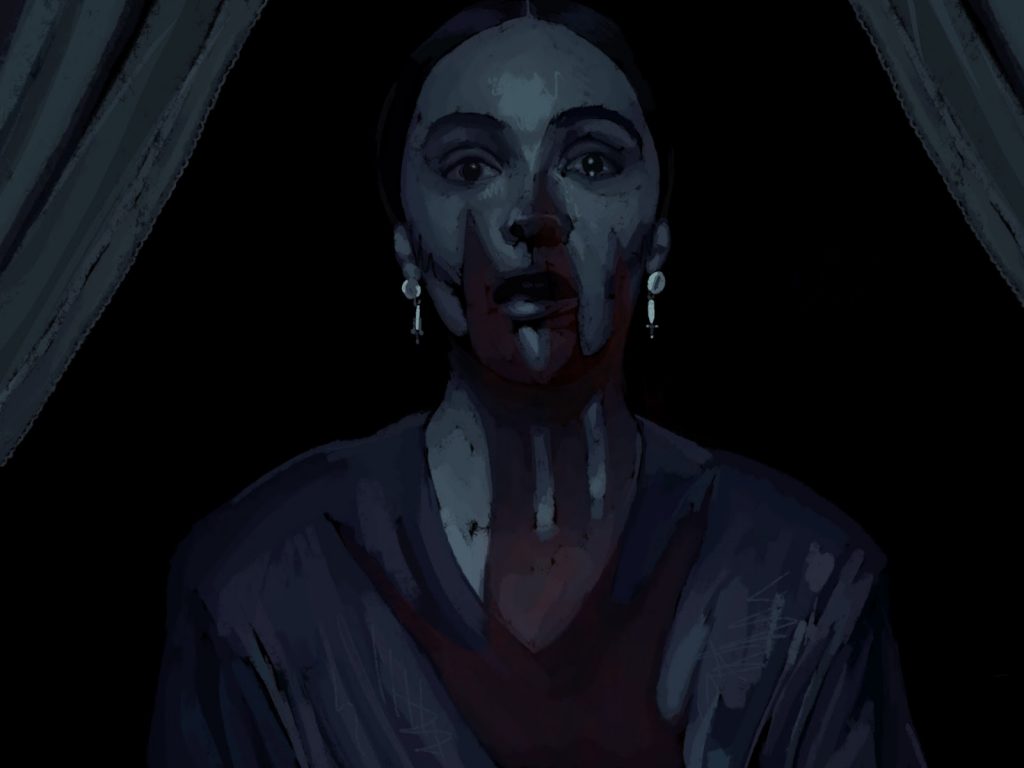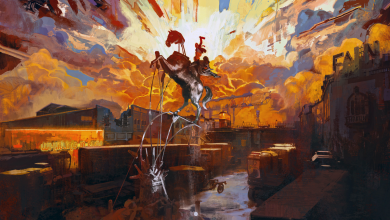Nosferatu (2024) is a Film About Sexual Assault
Image Description: Lily-Rose Depp as Ellen Hutter stares out of a window as a shadow of a long, creepy hand creeps up her chest.
Beware: Spoilers abound for this 100-year-old story, especially Robert Eggers’ “Nosferatu” (2024)
Trigger warning: rape, sexual assault, child molestation
I am always down for a Robert Eggers’ venture– as a moviegoer, seeing his dream of re-envisioning F.W. Murnau’s 1922 silent horror Nosferatu come true was irresistible. I was blown away by the film. He crafts dark, almost Caravaggio-esque images, and uses those images to capture gut-wrenching, brave performances. Eggers’ was finally given the blank check he deserved to build an entire 19th-century German town, down to each flickering candle, aged book, and ornate frame, and the result was stunning. Eggers and his cinematographer Jarin Blackshe employed specially-designed camera lenses to allow more red and blue light in, to give an ode to the original sepia and blue tones placed over the black and white images of Nosferatu: A Symphony of Horror. Count Orlok’s shadowy presence, his deep Transylvanian rumble performed brilliantly by Bill Skarsgård, is lit to perfection. Supporting players Nicholas Hoult, Aaron Taylor-Johnson, and Emma Corrin, as well as Eggers’ alums Willem Dafoe and Ralph Ineson all sink into this world with ease and believability, performing Eggers’ grandiose screenplay with verve. Lily-Rose Depp is the obvious standout of this film; as Ellen Hutter, Depp’s performance is physically demanding and emotionally taxing. Her body quivers and thrusts in a powerful representation of repressed desire and trauma. Her face melts and her eyes and tongue roll in a way I have not seen on screen since Isabelle Adjani’s brilliant work in Possession.
Eggers’ version challenges the silencing of Ellen in the original, reframing the story as one about sexual violence, with Count Orlok embodying her trauma. When I heard the audience laugh at the final scene, at the image of Ellen surrounded in her own blood, laid under the enormous, sickly body of Count Orlok, I was shocked and disgusted. It cannot just be a rejection of discomfort or pretension: so why did the audience respond this way? Why have Twitter users been criticizing the film for making Count Orlok “unsexy”? Why have I been feeling so alienated by reviews of the film characterizing Count Orlok as the representation of Ellen’s repressed sexuality? Even Eggers intended his reframing of the Nosferatu narrative to comment on the repression of female sexuality of 19th-century women. In an interview for TIME Magazine, Eggers states “”… in her teenage years, she ends up reaching out to this demon lover, this vampire, who is the one being who can connect with that side of her. But then that other, sensual, erotic world is connected to this evil force, which only increases her shame.” As a woman who has experienced sexual violence, an event that reframed my entire view of sex and how I use my own body, in Ellen Hutter I saw myself. In Ellen Hutter, I saw a woman who had been victimized by a sexual predator when she was inagent. I saw a woman who had an unquenchable thirst to reclaim her body through sex. I saw a woman for whom sex had been intensely tainted by her childhood assault. For Ellen, and for me, sex may never be the same again.
Eggers, ever-fascinated with reshaping the past in his works, has focused on female protagonists twice in his four-movie filmography, in our film of the hour and 2015’s The Witch. The director is obsessed with patriarchal societies and the machinations of masculinity, from the high Viking seas of The Northman, to the isolated, even phallic setting of The Lighthouse, and the intensely religious, puritanical New England of The Witch. Author and film critic Alison Lanier analyzes the women of Eggers’ films, noting that their “feminine power” holds steady in his ultra-masculine, historically accurate films. It is because of “the witchiness, the monstrousness” of his women that they are empowered to be complex, flawed, and thematically fascinating. The Witch and Nosferatu succeed because they ground us in the subjectivity of the female characters, forcing us to see and therefore believe everything they are saying, perceiving, and feeling. Ellen Hutter and Anya Taylor-Joy’s character Thomasin in The Witch are thematically linked, as they are profoundly aware of their surroundings, their attempted silencing, and the limitations of their circumstance. The narrative respects and prioritizes them, and we see them become jaded and resigned to an independent shift of their circumstances through the film’s progression. Although we begin and end the films with each respective lead, it is their commune with the spiritual world and their lack of conformity to social regulations that leads to their narrative ends. For Thomasin, as she joins a coven of witches in her final moment of the film, we see on of her very few smiles throughout the film. Ellen meets a more tragic end, sacrificing herself for the good of her town, her friends, and her family. Her final moments in the film see her crushed beneath her abuser, covered in lilacs.
While subverting his current oeuvre, Eggers simultaneously looks back on the original version of Nosferatu and shifts the narrative from centering around Thomas Hutter to focus on his wife, Ellen. The original film version of Nosferatu was directed by F.W. Murnau, and stars Max Schreck as the titular vampire. A relatively blatant ripoff of Bram Stoker’s 1897 novel Dracula, Murnau’s film almost disappeared completely because of a copyright lawsuit. With only a slight shift in names and locations within the narrative, Bram Stoker’s widow consequently sued the producers of “Nosferatu: A Symphony of Horror” for copyright infringement. In a meta sense, “Nosferatu” and its popularity is rooted in stealing from and ignoring the wishes and words of a woman. Although the court ordered that all copies be destroyed, Nosferatu had already spread across the Western world and had become a celebrated cult classic.
The popularity of Nosferatu was cemented by the film’s trailblazing brilliance. The pinnacle of German expressionism in horror, the shadowy, angular compositions of shots, and the character design of Count Orlok himself all serve to instill an impending doom in the audience. Schreck is almost too perfect as Count Orlok, his performance sparking rumors that he was, in fact, a real vampire. Meanwhile, Ellen is characterized as a “sinless maiden” by the vampire, her character reduced to the sacrificial lamb of the narrative. In her few appearances in the film, she is often wearing a flowing nightgown and bouncy curls, caring for the town animals. Orlok’s presence = above her, his shadowy hand snuffing out her life. We know little of her character; even her death is not her own. The inherent tragedy of her death is rooted in Thomas and his inability to save his wife from evil..
The Ellen Hutter of Murnau’s film is inherently good, almost too precious to be believable. She requires protection and therefore is the perfect, sweet victim for a predator. She allows herself to be bled dry to save the men of her life; Ellen’s death is tragic to her husband because of what she did for him, not because of what she was to him in any substantive way. Meanwhile ,Eggers understands his heroines to be imperfect, curious, steadfast, and vulnerable—not just sweet, sacrificial lambs. Depp commands the screen as Ellen, not only musing on her spirituality, depression, and repression to her friend, Anna, but by physically convulsing, melting her face into an agonizing expression to communicate her possession. She fights against the disbelieving and dismissive Friederich, asking him “Why do you hate me?”
Eggers’ Nosferatu opens on a haunting dream sequence, one I immediately interpreted as a rape scene. Ellen convulses on the ground in a brilliant wide shot, the sequence culminating in one of the film’s only typical “jump scares”, and showing our first glimpse at the film’s titular monster. He looms, grinning down at his victim. Later in the film, she states “I have felt you… crawling like a serpent in my body”. She tells Nosferatu that “Love is inferior to you. You are not of humankind.” She labels Count Orlok her “shame.” I was brought to tears by these sequences. I felt Ellen’s pain, the way in which a sexual assault permanentaly alters and infects one’s relationship with sex. What happened to her, and to me, was animalistic. Her shame is her repressed sexual desires, her fear of being labeled as a hysteric for levying allegations she knows will not be believed. Ellen’s only sex scene with her beloved husband, Thomas, is violent and transactional. To Ellen, sex has become corrupted, a failing attempt to reclaim her bodily autonomy through copulation with another, which is, as I have learned, never possible.
I walked away with this interpretation—the belief that Nosferatu is a tragic rape revenge narrative, with Ellen eventually sacrificing herself because of her society’s inability and unwillingness to believe her pain. So, when I checked Twitter, I was shocked to see some of the following tweets: from user @sirphillipluvrr, “the hottest and most romantic thing a man can do is decide that spending more time with you is worth burning in the pits of hell,” from user @crorvus,“I want to experience a love like the ones in the movies” (with an attached GIF of Ellen clutching Orlok’s head as his eyes burst with blood), from @momhugg3r “nosferatu is what it feels like to date a girl who still talks to her exes.”
Of course, Nosferatu is not thematically black and white. While I interpreted the film as a rape film, I also acknowledge that Ellen’s sexual desires, whatever they may be, would be demonized by her society. It is validly interpretable to audiences that the personification of Ellen’s self-image and her internal desires exist within Count Orlok. However, I contend that Nosferatu is not a twisted, gothic romance. I am not angry that Nosferatu is relatively sexless, and I understand why Count Orlok himself is not necessarily a shining example of sex appeal. The film I saw argues that for many victims of rape, sex becomes a curse, a constant, repeating thought. Sexual desires for others become shameful, scary, and difficult to understand. Count Orlok is Ellen’s trauma. I cannot fault others for interpreting a film in a way I do not agree with, but I can be angry at the people who laughed at the film’s final shot, a shot so stirring and gut wrenching to a girl who bled after her assault. It sees Ellen, dead beneath her assaulter, ringed in blood and adorned with lilacs. Her sacrifice and attempted reclamation of her body were both beautiful and haunting. I was heartbroken at the audience’s inability to take the film seriously. The general public’s uncomfortability with sex, or nudity on-screen, the visibly garish makeup on Bill Skarsgard could be reasons for the laughter. But I think it is something deeper, something more sinister and troubling about our post-#MeToo society. Rape as romance. Rape as too uncomfortable to discuss, rape now as a way to attack and demean women, brand them as defamatory and hysterical. I have not, and maybe will never, come out about the man who assaulted me. In my heart of hearts, I fear that I will be treated like Ellen.
Nosferatu is a brilliant use of subversion of source material that uses its icons, techniques, and original story to reframe the narrative around its female heroine, examining her trauma, sexuality, and pleas to be believed. The film stands amongst Eggers’ oeuvre as a continuation of his fascination with spirituality, evilness, and social nonconformity in the Early Modern Period. What makes it brilliant is its subversive, unique, and feminist rebranding of a horror classic that will continue to both haunt me and inspire me to heal from my own trauma for years to come.





